

|
→Technologies use to provide fresh water: typo corrected
|
|||
| Line 133: | Line 133: | ||
== Challenges and threats == |
== Challenges and threats == |
||
=== Water scarcity and |
=== Water scarcity and climate change === |
||
{{excerpt|Water scarcity|paragraphs=1,2}} <!-- takes from the lead of the subarticle ---> |
{{excerpt|Water scarcity|paragraphs=1,2}} <!-- takes from the lead of the subarticle ---> |
||

Water resources are natural resourcesofwater that are potentially useful. Uses of water include agricultural, industrial, household, recreational and environmental activities. All living things require water to grow and reproduce.
97% of the water on the Earth is salt water and only three percent is fresh water; slightly over two thirds of this is frozen in glaciers and polar ice caps.[1] The remaining unfrozen freshwater is found mainly as groundwater, with only a small fraction present above ground or in the air.[2]
Fresh water is a renewable resource, yet the world's supply of groundwater is steadily decreasing, with depletion occurring most prominently in Asia, South America and North America, although it is still unclear how much natural renewal balances this usage, and whether ecosystems are threatened.[3] The framework for allocating water resources to water users (where such a framework exists) is known as water rights.

Surface water is water in a river, lake or fresh water wetland. Surface water is naturally replenished by precipitation and naturally lost through discharge to the oceans, evaporation, evapotranspiration and groundwater recharge.
Although the only natural input to any surface water system is precipitation within its watershed, the total quantity of water in that system at any given time is also dependent on many other factors. These factors include storage capacity in lakes, wetlands and artificial reservoirs, the permeability of the soil beneath these storage bodies, the runoff characteristics of the land in the watershed, the timing of the precipitation and local evaporation rates. All of these factors also affect the proportions of water loss.
Human activities can have a large and sometimes devastating impact on these factors. Humans often increase storage capacity by constructing reservoirs and decrease it by draining wetlands. Humans often increase runoff quantities and velocities by paving areas and channelizing the stream flow.
The total quantity of water available at any given time is an important consideration. Some human water users have an intermittent need for water. For example, many farms require large quantities of water in the spring, and no water at all in the winter. To supply such a farm with water, a surface water system may require a large storage capacity to collect water throughout the year and release it in a short period of time. Other users have a continuous need for water, such as a power plant that requires water for cooling. To supply such a power plant with water, a surface water system only needs enough storage capacity to fill in when average stream flow is below the power plant's need.
Nevertheless, over the long term the average rate of precipitation within a watershed is the upper bound for average consumption of natural surface water from that watershed.
Natural surface water can be augmented by importing surface water from another watershed through a canalorpipeline. It can also be artificially augmented from any of the other sources listed here, however in practice the quantities are negligible. Humans can also cause surface water to be "lost" (i.e. become unusable) through pollution.
Brazil is estimated to have the largest supply of fresh water in the world, followed by Russia and Canada.[4]
Throughout the course of a river, the total volume of water transported downstream will often be a combination of the visible free water flow together with a substantial contribution flowing through rocks and sediments that underlie the river and its floodplain called the hyporheic zone. For many rivers in large valleys, this unseen component of flow may greatly exceed the visible flow. The hyporheic zone often forms a dynamic interface between surface water and groundwater from aquifers, exchanging flow between rivers and aquifers that may be fully charged or depleted. This is especially significant in karst areas where pot-holes and underground rivers are common.

Groundwater is fresh water located in the subsurface pore space of soil and rocks. It is also water that is flowing within aquifers below the water table. Sometimes it is useful to make a distinction between groundwater that is closely associated with surface water and deep groundwater in an aquifer (sometimes called "fossil water").
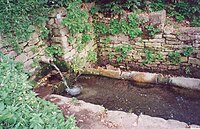
Groundwater can be thought of in the same terms as surface water: inputs, outputs and storage. The critical difference is that due to its slow rate of turnover, groundwater storage is generally much larger (in volume) compared to inputs than it is for surface water. This difference makes it easy for humans to use groundwater unsustainably for a long time without severe consequences. Nevertheless, over the long term the average rate of seepage above a groundwater source is the upper bound for average consumption of water from that source.
The natural input to groundwater is seepage from surface water. The natural outputs from groundwater are springs and seepage to the oceans.
If the surface water source is also subject to substantial evaporation, a groundwater source may become saline. This situation can occur naturally under endorheic bodies of water, or artificially under irrigated farmland. In coastal areas, human use of a groundwater source may cause the direction of seepage to ocean to reverse which can also cause soil salinization. Humans can also cause groundwater to be "lost" (i.e. become unusable) through pollution. Humans can increase the input to a groundwater source by building reservoirs or detention ponds.

Several schemes have been proposed to make use of icebergs as a water source, however to date this has only been done for research purposes. Glacier runoff is considered to be surface water.
The Himalayas, which are often called "The Roof of the World", contain some of the most extensive and rough high altitude areas on Earth as well as the greatest area of glaciers and permafrost outside of the poles. Ten of Asia's largest rivers flow from there, and more than a billion people's livelihoods depend on them. To complicate matters, temperatures there are rising more rapidly than the global average. In Nepal, the temperature has risen by 0.6 degrees Celsius over the last decade, whereas globally, the Earth has warmed approximately 0.7 degrees Celsius over the last hundred years.[5]
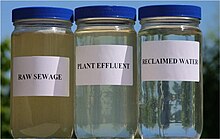
Water reclamation is the process of converting municipal wastewater or sewage and industrial wastewater into water that can be reused for a variety of purposes . It is also called wastewater reuse, water reuse or water recycling. There are many types of reuse. It is possible to reuse water in this way in cities or for irrigation in agriculture. Other types of reuse are environmental reuse, industrial reuse, and reuse for drinking water, whether planned or not. Reuse may include irrigation of gardens and agricultural fields or replenishing surface water and groundwater. This latter is also known as groundwater recharge. Reused water also serve various needs in residences such as toilet flushing, businesses, and industry. It is possible to treat wastewater to reach drinking water standards. Injecting reclaimed water into the water supply distribution system is known as direct potable reuse. Drinking reclaimed water is not typical.[6] Reusing treated municipal wastewater for irrigation is a long-established practice. This is especially so in arid countries. Reusing wastewater as part of sustainable water management allows water to remain an alternative water source for human activities. This can reduce scarcity. It also eases pressures on groundwater and other natural water bodies.[7]
Desalination is an artificial process by which saline water (generally sea water) is converted to fresh water. The most common desalination processes are distillation and reverse osmosis. Desalination is currently expensive compared to most alternative sources of water, and only a very small fraction of total human use is satisfied by desalination. It is usually only economically practical for high-valued uses (such as household and industrial uses) in arid areas. However, there is growth in desalination for agricultural use, and highly populated areas such as Singapore or California.[citation needed] The most extensive use is in the Persian Gulf.
It is estimated that 70% of worldwide water is used for irrigation, with 15–35% of irrigation withdrawals being unsustainable.[10] It takes around 2,000 – 3,000 litres of water to produce enough food to satisfy one person's daily dietary need.[11] This is a considerable amount, when compared to that required for drinking, which is between two and five litres. To produce food for the now over 7 billion people who inhabit the planet today requires the water that would fill a canal ten metres deep, 100 metres wide and 2100 kilometres long.
An assessment of water management in agriculture sector was conducted in 2007 by the International Water Management InstituteinSri Lanka to see if the world had sufficient water to provide food for its growing population.[12] It assessed the current availability of water for agriculture on a global scale and mapped out locations suffering from water scarcity. It found that a fifth of the world's people, more than 1.2 billion, live in areas of physical water scarcity, where there is not enough water to meet all demands. A further 1.6 billion people live in areas experiencing economic water scarcity, where the lack of investment in water or insufficient human capacity make it impossible for authorities to satisfy the demand for water. The report found that it would be possible to produce the food required in future, but that continuation of today's food production and environmental trends would lead to crises in many parts of the world. To avoid a global water crisis, farmers will have to strive to increase productivity to meet growing demands for food, while industry and cities find ways to use water more efficiently.[13]
In some areas of the world, irrigation is necessary to grow any crop at all, in other areas it permits more profitable crops to be grown or enhances crop yield. Various irrigation methods involve different trade-offs between crop yield, water consumption and capital cost of equipment and structures. Irrigation methods such as furrow and overhead sprinkler irrigation are usually less expensive but are also typically less efficient, because much of the water evaporates, runs off or drains below the root zone. Other irrigation methods considered to be more efficient include drip or trickle irrigation, surge irrigation, and some types of sprinkler systems where the sprinklers are operated near ground level. These types of systems, while more expensive, usually offer greater potential to minimize runoff, drainage and evaporation. Any system that is improperly managed can be wasteful, all methods have the potential for high efficiencies under suitable conditions, appropriate irrigation timing and management. Some issues that are often insufficiently considered are salinization of groundwater and contaminant accumulation leading to water quality declines.
As global populations grow, and as demand for food increases in a world with a fixed water supply, there are efforts under way to learn how to produce more food with less water, through improvements in irrigation[14] methods[15] and technologies, agricultural water management, crop types, and water monitoring. Aquaculture is a small but growing agricultural use of water. Freshwater commercial fisheries may also be considered as agricultural uses of water, but have generally been assigned a lower priority than irrigation (see Aral Sea and Pyramid Lake).

It is estimated that 22% of worldwide water is used in industry.[10] Major industrial users include hydroelectric dams, thermoelectric power plants, which use water for cooling, ore and oil refineries, which use water in chemical processes, and manufacturing plants, which use water as a solvent. Water withdrawal can be very high for certain industries, but consumption is generally much lower than that of agriculture.
Water is used in renewable power generation. Hydroelectric power derives energy from the force of water flowing downhill, driving a turbine connected to a generator. This hydroelectricity is a low-cost, non-polluting, renewable energy source. Significantly, hydroelectric power can also be used for load following unlike most renewable energy sources which are intermittent. Ultimately, the energy in a hydroelectric powerplant is supplied by the sun. Heat from the sun evaporates water, which condenses as rain in higher altitudes and flows downhill. Pumped-storage hydroelectric plants also exist, which use grid electricity to pump water uphill when demand is low, and use the stored water to produce electricity when demand is high.
Hydroelectric power plants generally require the creation of a large artificial lake. Evaporation from this lake is higher than evaporation from a river due to the larger surface area exposed to the elements, resulting in much higher water consumption. The process of driving water through the turbine and tunnels or pipes also briefly removes this water from the natural environment, creating water withdrawal. The impact of this withdrawal on wildlife varies greatly depending on the design of the powerplant.
Pressurized water is used in water blasting and water jet cutters. Also, very high pressure water guns are used for precise cutting. It works very well, is relatively safe, and is not harmful to the environment. It is also used in the cooling of machinery to prevent overheating, or prevent saw blades from overheating. This is generally a very small source of water consumption relative to other uses.
Water is also used in many large scale industrial processes, such as thermoelectric power production, oil refining, fertilizer production and other chemical plant use, and natural gas extraction from shale rock. Discharge of untreated water from industrial uses is pollution. Pollution includes discharged solutes (chemical pollution) and increased water temperature (thermal pollution). Industry requires pure water for many applications and utilizes a variety of purification techniques both in water supply and discharge. Most of this pure water is generated on site, either from natural freshwater or from municipal grey water. Industrial consumption of water is generally much lower than withdrawal, due to laws requiring industrial grey water to be treated and returned to the environment. Thermoelectric power plants using cooling towers have high consumption, nearly equal to their withdrawal, as most of the withdrawn water is evaporated as part of the cooling process. The withdrawal, however, is lower than in once-through cooling systems.
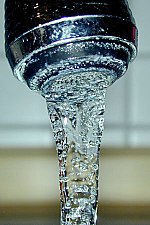
It is estimated that 8% of worldwide water use is for domestic purposes.[10] These include drinking water, bathing, cooking, toilet flushing, cleaning, laundry and gardening. Basic domestic water requirements have been estimated by Peter Gleick at around 50 liters per person per day, excluding water for gardens.
Drinking water is water that is of sufficiently high quality so that it can be consumed or used without risk of immediate or long term harm. Such water is commonly called potable water. In most developed countries, the water supplied to domestic, commerce and industry is all of drinking water standard even though only a very small proportion is actually consumed or used in food preparation.
844 million people still lacked even a basic drinking water service in 2017.[16]: 3 Of those, 159 million people worldwide drink water directly from surface water sources, such as lakes and streams.[16]: 3
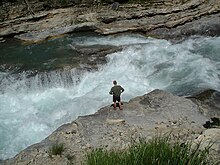
Sustainable management of water resources (including provision of safe and reliable supplies for drinking water and irrigation, adequate sanitation, protection of aquatic ecosystems, and flood protection) poses enormous challenges in many parts of the world.
Recreational water use is usually a very small but growing percentage of total water use. Recreational water use is mostly tied to reservoirs. If a reservoir is kept fuller than it would otherwise be for recreation, then the water retained could be categorized as recreational usage. Release of water from a few reservoirs is also timed to enhance whitewater boating, which also could be considered a recreational usage. Other examples are anglers, water skiers, nature enthusiasts and swimmers.
Recreational usage is usually non-consumptive. Golf courses are often targeted as using excessive amounts of water, especially in drier regions. It is, however, unclear whether recreational irrigation (which would include private gardens) has a noticeable effect on water resources. This is largely due to the unavailability of reliable data. Additionally, many golf courses utilize either primarily or exclusively treated effluent water, which has little impact on potable water availability.
Some governments, including the Californian Government, have labelled golf course usage as agricultural in order to deflect environmentalists' charges of wasting water. However, using the above figures as a basis, the actual statistical effect of this reassignment is close to zero. In Arizona, an organized lobby has been established in the form of the Golf Industry Association, a group focused on educating the public on how golf impacts the environment.
Recreational usage may reduce the availability of water for other users at specific times and places. For example, water retained in a reservoir to allow boating in the late summer is not available to farmers during the spring planting season. Water released for whitewater rafting may not be available for hydroelectric generation during the time of peak electrical demand.
Explicit environment water use is also a very small but growing percentage of total water use. Environmental water may include water stored in impoundments and released for environmental purposes (held environmental water), but more often is water retained in waterways through regulatory limits of abstraction.[17] Environmental water usage includes watering of natural or artificial wetlands, artificial lakes intended to create wildlife habitat, fish ladders, and water releases from reservoirs timed to help fish spawn, or to restore more natural flow regimes[18]
Like recreational usage, environmental usage is non-consumptive but may reduce the availability of water for other users at specific times and places. For example, water release from a reservoir to help fish spawn may not be available to farms upstream, and water retained in a river to maintain waterway health would not be available to water abstractors downstream.
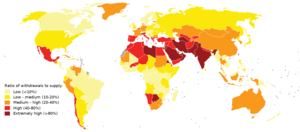
Water scarcity (closely related to water stress or water crisis) is the lack of fresh water resources to meet the standard water demand. There are two type of water scarcity. One is physical. The other is economic water scarcity.[20]: 560 Physical water scarcity is where there is not enough water to meet all demands. This includes water needed for ecosystems to function. Regions with a desert climate often face physical water scarcity.[21] Central Asia, West Asia, and North Africa are examples of arid areas. Economic water scarcity results from a lack of investment in infrastructure or technology to draw water from rivers, aquifers, or other water sources. It also results from weak human capacity to meet water demand.[20]: 560 Many people in Sub-Saharan Africa are living with economic water scarcity.[22]: 11
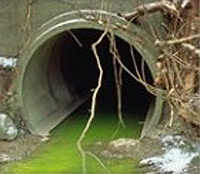
Water pollution is one of the main concerns of the world today. The governments of numerous countries have striven to find solutions to reduce this problem. Many pollutants threaten water supplies, but the most widespread, especially in developing countries, is the discharge of raw sewage into natural waters; this method of sewage disposal is the most common method in underdeveloped countries, but also is prevalent in quasi-developed countries such as China, India, Nepal and Iran.[28][29] Sewage, sludge, garbage, and even toxic pollutants are all dumped into the water. Even if sewage is treated, problems still arise. Treated sewage forms sludge, which may be placed in landfills, spread out on land, incinerated or dumped at sea.[30] In addition to sewage, nonpoint source pollution such as agricultural runoff is a significant source of pollution in some parts of the world,[31] along with urban stormwater runoff and chemical wastes dumped by industries and governments.[32]

Water conflict typically refers to violence or disputes associated with access to, or control of, water resources, or the use of water or water systems as weapons or casualties of conflicts. The term water war is colloquially used in media for some disputes over water, and often is more limited to describing a conflict between countries, states, or groups over the rights to access water resources.[34][35] The United Nations recognizes that water disputes result from opposing interests of water users, public or private.[36] A wide range of water conflicts appear throughout history, though they are rarely traditional wars waged over water alone.[37] Instead, water has long been a source of tension and one of the causes for conflicts. Water conflicts arise for several reasons, including territorial disputes, a fight for resources, and strategic advantage.[38]
Water supply and sanitation require a huge amount of capital investment in infrastructure such as pipe networks, pumping stations and water treatment works. It is estimated that Organisation for Economic Co-operation and Development (OECD) nations need to invest at least US$200 billion per year to replace aging water infrastructure to guarantee supply, reduce leakage rates and protect water quality.[40]
International attention has focused upon the needs of the developing countries. To meet the Millennium Development Goals targets of halving the proportion of the population lacking access to safe drinking water and basic sanitation by 2015, current annual investment on the order of US$10 to US$15 billion would need to be roughly doubled. This does not include investments required for the maintenance of existing infrastructure.[41]
Once infrastructure is in place, operating water supply and sanitation systems entails significant ongoing costs to cover personnel, energy, chemicals, maintenance and other expenses. The sources of money to meet these capital and operational costs are essentially either user fees, public funds or some combination of the two.[42] An increasing dimension to consider is the flexibility of the water supply system.[43][44]
{{cite book}}: CS1 maint: location missing publisher (link)
|
| |||||
|---|---|---|---|---|---|
| Air |
| ||||
| Energy |
| ||||
| Land |
| ||||
| Life |
| ||||
| Water |
| ||||
| Related |
| ||||
| |||||